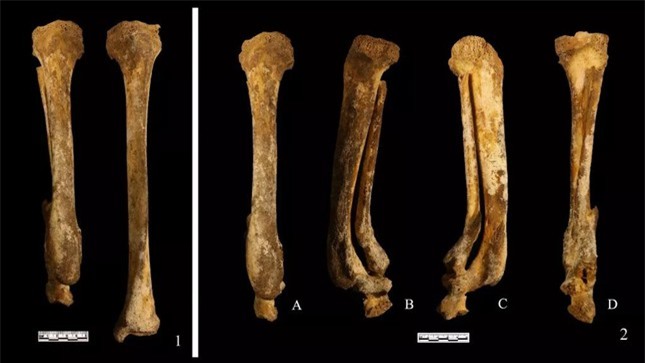Ancient skeletons reveal the punishment of cutting off the feet of Chinese women 3,000 years ago

Analysis of the foot bone of a Chinese woman 3,000 years ago found it amputated.
This is one of the few times archaeologists have discovered evidence of an ancient Chinese punishment.
Images taken of 2 leg bones at different angles show that the right leg is amputated. The bumpy end on the bone of the right shin indicates that the amputation was a punishment, not the result of an accident or illness.
Various clues suggest that the woman’s foot was severed, and it appears the wound was made roughly.
The study’s lead author Li Nan, an archaeologist at Peking University in China, said the researchers looked at other possibilities that the woman might have lost her leg, such as: due to accident, war trauma or surgery. However, after careful observation and discussion in the media, the team ruled out other possibilities and agreed that punitive amputation is the most likely explanation.
Punishment for cutting off legs
The penalty of amputation was common in ancient China for more than 1,000 years, until it was abolished in the second century BC, according to a 2019 study in the Chinese Tsinghua Law Journal. At the time this woman was alive, there were as many as 500 different offenses that could have resulted in a leg amputation, including sedition, fraud, stealing, and even climbing over certain restricted areas.
Five brutal punishments for felonies
According to historians, yue (The punishment of amputation of one or both feet) was one of the “five punishments for slaves” enforced from the second millennium BC by the emperors of the dynasty. Xia Dynasty, the first dynasty of ancient China.
There is plenty of historical evidence for this, and a Chinese official in the first millennium BC complained about the need to find special shoes for amputees.
Misdemeanors are beaten, but serious offenders can be punished with one of five penalties: mo (tattoo with indelible ink on the face or forehead); yi (the offender had his nose cut off); yue (feet amputation; some of the heaviest offenders have both feet amputated); and gōng (castrated).
The fifth is da pi, a death sentence that can be carried out by beheading, where with luck there may be alternatives including being boiled alive and torn to pieces by a horse, according to a 1975 study in the Journal Journal of International & Comparative Law of Georgia.
Chinese tradition records that the five punishments were in effect until they were abolished by Emperor Wen of the Han dynasty in the second century BC and replaced by fines, beatings, and hard labor. wrong and exile.
Historical works and artwork demonstrate yue retribution in ancient China, including bronzes from the first millennium BC. These works depict people losing a leg or a foot as punishment; They are traditionally employed as gatekeepers.
This woman’s skeleton found in a tomb at Zhouyuan in northwest China’s Shaanxi province in 1999 is one of many evidences of ancient punishment. The tomb dates from 2,800 to 3,000 years ago, at that time Zhouyuan was the largest and most important city in the region.
An anatomical analysis revealed that the woman was between 30 and 35 years old when she died, and – aside from her missing foot – was in excellent health. She did not appear to be ill after the amputation, which suggests that she was well taken care of; and the growth of the remaining leg bones suggest that the woman lived for about 5 more years before dying.
Several bullet casings were found in her grave, which may indicate that she lived in poverty and that she was possibly buried by family members.
This woman’s bones show no signs of any disease that might necessitate amputation of the foot, such as diabetes, leprosy or cancer; and there was no evidence of frostbite or burns.
at Blogtuan.info – Source: danviet.vn – Read the original article here

